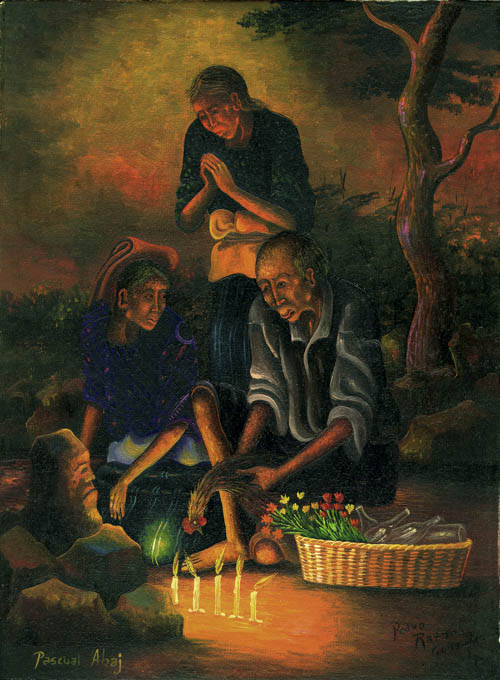|
Pascaul Abaj by Pedro Rafaél González Chavajay, 1988
In the painting by Pedro Rafaél, a family performs a ritual at the pre-Hispanic shrine of Pascual Abaj,
on a hilltop outside the town of Chichicastenango. They have come secretly in the darkness, bringing their offerings
of candles, flowers, alcohol, and a chicken to sacrifice. They may be asking for help with a new endeavor, for the
health of a family member, or possibly for a good harvest.
Pascual Abaj, a dark stone bearing a sculpted face, stands in the center of one of the Maya sacred sites called Turq’a’,
also known as Chilima’. This is located atop a wooded hill on the outskirts of the town of Chichicastenango, where since
pre-Hispanic times the Maya have performed their spiritual ceremonies. People travel to the town to buy the objects for
their offering.
Another sacred place in Chichicastenango is the site of the Catholic church, specifically the atrium of the current church.
It was there that the Maya had their ancient stones and other sacred elements. In 1925, Catholic priests came there to
Christianize and impose their religious practices on the K’iche’ Maya. For example, in 1940 they deliberately constructed
a new Catholic church directly over the ancient Maya ceremonial altar and installed Christian images and altarpieces.
When members of the Chichicastenango cofradías (religious brotherhoods) saw the construction plans for the church in
the sacred place, they decided to move the ancient stones to the top of the Chilima’ hill, where they currently accompany
the Pascual stone.
Maya ceremonies are complex, in terms of the content of each offering made by the ajq’ijab’. The offerings are made at various
sites, some of which may be found in forests, such as the woods where Pascual Abaj is located; the Church of Santo Tomás;
or several chapels of the brotherhoods around the town.
Many types of ceremonies are performed, including the following: thanksgiving; the commemoration of the dead; the reception
of the ajq’iij; invocation of one’s Ch’umilal or rajawal (animal spirit); asking forgiveness at the beginning of a venture or
giving thanks afterwards; liberation from one’s own bad thoughts; cure for a disease caused by a dead enemy; prayer to appease
the spirits of the earth; restoration of lost money; and witchcraft against the theft of corn (Bunzel 1952).
Today, both male and female ajq’ijab’ perform ceremonies in the Mayan Quiché language, except for the Spanish name Jesus Christ
inserted in the prayers. The rituals use white, red, yellow, and black candles that represent the Maya colors for the four
points of the compass; and offerings such as flowers, sugar, chocolate, cakes, aguardiente (a strong alcohol) and occasionally
an animal sacrifice. The reason for the ceremony dictates the number and color of the candles, as well as the type of offering.
In earlier times, most Maya people, although nominally Catholic, concealed their traditional Maya religious beliefs. Like the
family in Pedro Rafaél ’s painting, they visited the place secretly at night to avoid disapproval by the Catholic Church.
|
|
Adoration of the Rock Pascual, Chichicastenangoby by Mariano González Chavajay, 2001.
The stone’s original Mayan name may have been Loq’olaj ab’aj (Sacred Rock), but the site is now known as Pascual Abaj
(Pascual Rock). Pascual is a Spanish name, but it is not clear who the rock is named for. One possibility is that it is named after
Pascal Baylón, a 16th century Franciscan friar who helped the sick and the poor and became a Catholic saint. Pascal Baylón’s feast
day is May 17, the same day that the Maya celebrate Pascual the King (El Rey Pascual), a popular saint also known as San Pascual.
People pray to El Rey Pascual for communion with the dead and with their ancestors, and for healing. Pascual Abaj, however, does
not have this strong connection to the dead. (Pieper 2002)
Another explanation for the name Pascual comes from Manuel Pan Ju Lux, an
ajq’iij from Chichicastenango. He says that their ancestors
had trouble constructing the current church of Saint Thomas church in Chichicastenango. The adobe kept collapsing. They thought it
could be due to a lack of proper ceremonies. One day a large man named Pascual came to assist them, but since he had no Mayan name,
they were reluctant to let him help. However, when they accepted his help, the construction of the church went forward. At the end
of each day, the man would walk into the forest and disappear. One day they followed him, and at the place where he disappeared,
there was a stone. Pascual never appeared again, and from that moment the ancestors called the stone Pascual Abaj and worshiped
there. This story gave a Christian context to this ancient site: it was the rock that represented the main builder of the local
church, and it may be a means used by the K’iche’ Maya to protect their sacred place from destruction by the Spanish.
In the painting by Mariano, Maya spiritual guides offer sacrifices. Pascual Abaj is one of hundreds of sacred sites outside of the
Maya towns in Guatemala, where traditional Maya rituals have been performed in secret for centuries.
Bunzel, Ruth Leah. 1952. Chichicastenango, a Guatemala Village. Locust Valley, NY: J.J. Agustin.
Pieper, Jim. 2002. Guatemala’s Folk Saints. Los Angeles, Pieper and Associates, Inc.
|

